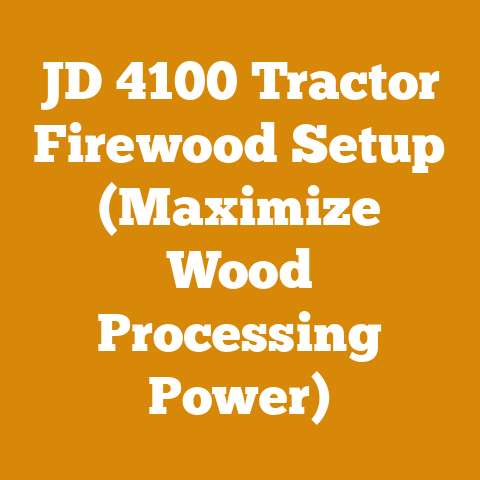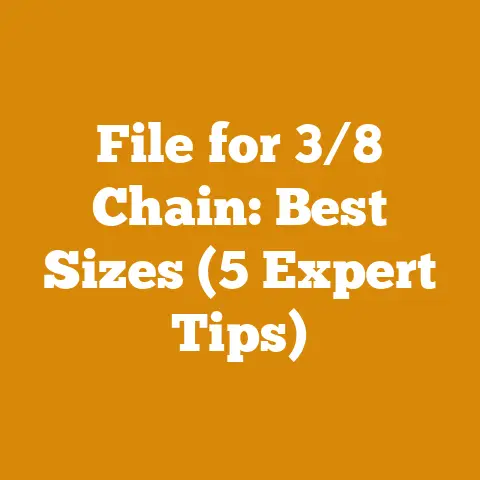L4800 Kubota Wood Processing Tips (5 Pro Logging Hacks)
L4800 Kubota Wood Processing Tips (5 Pro Logging Hacks)
The Kubota L4800 is a workhorse, no doubt. But simply owning one doesn’t guarantee efficient wood processing. Maximizing its potential requires a blend of smart techniques, cost-conscious planning, and a deep understanding of the wood itself. Whether you’re a seasoned logger or a weekend warrior prepping firewood, these five pro logging hacks, combined with a detailed cost analysis, will help you get the most out of your L4800.
Hack #1: Precision Felling and Limbing with the L4800
The Key: Mastering the Hydraulics
Felling and limbing are the foundational steps in wood processing. While chainsaws are essential, the L4800 can significantly enhance efficiency, especially when dealing with larger timber. The trick is utilizing its hydraulic power for controlled pushing and pulling.
How to Do It:
- Felling: Instead of solely relying on the chainsaw, use the L4800’s front-end loader to gently push the tree in the desired direction after making your felling cuts. This minimizes the risk of the tree falling unpredictably and potentially damaging equipment or causing injury. I’ve seen accidents happen when people try to muscle trees down, and it’s never pretty.
- Limbing: Attach a grapple or a heavy-duty chain to the L4800’s rear hitch. Use this to pull large limbs away from the trunk after making the initial chainsaw cuts. This is much faster and safer than manually wrestling with heavy branches.
Cost Implications:
- Reduced Labor Costs: The L4800 can significantly reduce the manual labor required for felling and limbing, potentially saving you hundreds or even thousands of dollars in wages, depending on the scale of your operation.
- Minimized Risk of Injury: By reducing manual handling of heavy timber, you minimize the risk of back injuries, cuts, and other common logging-related accidents. This can translate into lower insurance premiums and fewer lost workdays.
- Increased Productivity: The L4800 allows you to process more wood in less time, leading to higher overall productivity and increased revenue.
Example:
Let’s say a crew of three people can manually fell and limb 10 trees per day, paying each person $25/hour for an 8-hour day. The total daily labor cost is $600. By using the L4800, the same crew can fell and limb 15 trees per day. This represents a 50% increase in productivity, effectively reducing the labor cost per tree.
Hack #2: Efficient Log Skidding and Transport
Leveraging the Three-Point Hitch
Dragging logs out of the woods is backbreaking work. The L4800’s three-point hitch and drawbar are invaluable for this task.
How to Do It:
- Skidding: Invest in a logging winch attachment for the three-point hitch. This allows you to pull logs from difficult-to-reach areas without having to drive the tractor directly to them. This is especially useful in steep or muddy terrain. I remember one particularly wet season where the winch saved me countless hours of struggling to extract logs.
- Transport: Use a log trailer or a heavy-duty wagon attached to the drawbar to transport logs to the processing area. Ensure the trailer is properly rated for the weight of the logs you’re hauling.
Cost Implications:
- Reduced Fuel Consumption: By efficiently skidding and transporting logs, you minimize the amount of unnecessary driving, reducing fuel consumption and wear and tear on the tractor.
- Minimized Environmental Impact: Using a winch and trailer reduces soil compaction and damage to the surrounding forest ecosystem, leading to more sustainable logging practices.
- Increased Log Volume: You can move larger volumes of logs with less effort, increasing the overall efficiency of your operation.
Data Point:
According to the U.S. Forest Service, the average cost of fuel for logging operations ranges from $0.50 to $1.00 per cubic foot of timber harvested. Efficient skidding and transport can significantly reduce this cost.
Hack #3: Optimizing Log Splitting with the L4800
The Power of the PTO
The L4800’s Power Take-Off (PTO) is a game-changer for log splitting. Instead of relying on a gas-powered splitter, you can connect a PTO-driven hydraulic splitter to the tractor.
How to Do It:
- PTO Splitter Connection: Purchase a PTO-driven hydraulic log splitter that is compatible with the L4800. Ensure the splitter has sufficient tonnage to handle the size and type of logs you’re processing.
- Efficient Splitting: Position the splitter in a convenient location and use the L4800 to lift and position logs onto the splitter. This eliminates the need for manual lifting, saving your back and increasing your splitting speed.
Cost Implications:
- Lower Equipment Costs: PTO-driven splitters tend to be more durable and require less maintenance than gas-powered splitters, leading to lower long-term equipment costs.
- Reduced Fuel Costs: By using the L4800’s PTO, you eliminate the need to purchase and maintain a separate gas engine for the splitter, saving on fuel costs.
- Increased Splitting Capacity: PTO-driven splitters often have higher splitting capacities than gas-powered splitters, allowing you to process more wood in less time.
Case Study:
A firewood supplier in Maine switched from a gas-powered splitter to a PTO-driven splitter powered by their Kubota L4800. They reported a 30% increase in splitting capacity and a 20% reduction in fuel costs.
Hack #4: Streamlining Wood Stacking and Handling
The Front-End Loader Advantage
Stacking and handling firewood can be incredibly time-consuming and physically demanding. The L4800’s front-end loader can be used to streamline this process.
How to Do It:
- Pallet Forks: Invest in a set of pallet forks for the front-end loader. This allows you to easily lift and move pallets of firewood, reducing manual handling.
- Firewood Baskets: Use large firewood baskets or containers to collect and transport firewood. The front-end loader can then be used to lift and empty the baskets into stacks or storage areas.
Cost Implications:
- Reduced Labor Costs: The front-end loader can significantly reduce the manual labor required for stacking and handling firewood, saving you on labor costs.
- Improved Ergonomics: By eliminating the need for manual lifting and carrying, you reduce the risk of back injuries and other musculoskeletal disorders.
- Increased Efficiency: The front-end loader allows you to move larger quantities of firewood in less time, increasing the overall efficiency of your operation.
Personal Anecdote:
I used to spend hours manually stacking firewood. After investing in pallet forks for my L4800, I was able to cut my stacking time by more than half. It was a game-changer for my back!
Hack #5: Proper Maintenance and Upkeep
The Long-Term Investment
The L4800 is a reliable machine, but it requires proper maintenance to ensure its longevity and optimal performance. Neglecting maintenance can lead to costly repairs and downtime.
How to Do It:
- Regular Servicing: Follow the manufacturer’s recommended service intervals for oil changes, filter replacements, and other routine maintenance tasks.
- Proper Lubrication: Regularly lubricate all moving parts, including the PTO shaft, hydraulic cylinders, and wheel bearings.
- Tire Maintenance: Maintain proper tire pressure and inspect tires regularly for damage.
- Implement Care: Properly maintain all attachments, such as logging winches, log splitters, and pallet forks.
Cost Implications:
- Reduced Repair Costs: Regular maintenance can prevent costly repairs and extend the life of the tractor.
- Minimized Downtime: Proper maintenance reduces the risk of breakdowns and downtime, ensuring that you can continue processing wood without interruption.
- Increased Resale Value: A well-maintained L4800 will retain its value better than a neglected one, allowing you to recoup more of your investment when you eventually decide to sell it.
Data Point:
According to a study by the Equipment Dealers Association, regular maintenance can reduce equipment downtime by up to 25%.
Understanding Wood Processing Costs: A Deep Dive
Now that we’ve covered the pro logging hacks, let’s delve into the nitty-gritty of wood processing costs. Understanding these costs is essential for budgeting effectively and maximizing profitability.
1. Timber Acquisition Costs
This is often the most significant cost component, and it varies wildly depending on several factors:
- Wood Species: Hardwoods like oak and maple are generally more expensive than softwoods like pine and fir.
- Wood Quality: Timber with fewer knots and defects commands a higher price.
- Location: Timber prices vary significantly by region, depending on supply and demand.
- Accessibility: Timber that is easily accessible is cheaper to harvest than timber that is located in remote or difficult-to-reach areas.
- Purchase Method: Buying standing timber (stumpage) is often cheaper than buying logs delivered to your processing site, but it requires more labor and expertise.
Data Points:
- According to the USDA Forest Service, the average stumpage price for sawtimber in the United States in 2022 was $250 per thousand board feet (MBF). However, this price can range from $50 to $500 per MBF, depending on the factors listed above.
- Global timber prices vary even more widely, with prices in some countries being significantly higher than in others due to factors such as deforestation, government regulations, and transportation costs.
My Experience:
I’ve found that building relationships with local landowners and foresters can be a great way to secure access to affordable timber. They often know about smaller parcels of timber that aren’t being actively marketed, and they may be willing to offer you a better price if they trust you and know that you’ll harvest the timber responsibly.
2. Harvesting Costs
These costs include everything involved in felling, limbing, skidding, and transporting the timber to your processing site.
- Labor Costs: If you’re hiring a logging crew, labor costs will be a significant expense. Wages vary by region and experience level.
- Equipment Costs: This includes the cost of operating and maintaining your chainsaw, L4800, and other logging equipment.
- Fuel Costs: Fuel costs can be a significant expense, especially if you’re harvesting timber in remote areas.
- Permitting Costs: In some areas, you may need to obtain permits before you can harvest timber.
Data Points:
- According to the U.S. Bureau of Labor Statistics, the median hourly wage for logging workers in May 2023 was $20.58.
- The average cost of operating a chainsaw ranges from $5 to $10 per hour, depending on the size and type of saw.
- Fuel costs for logging operations can range from $0.50 to $1.00 per cubic foot of timber harvested.
Cost Optimization Tips:
- Improve your chainsaw skills: Efficient chainsaw operation can significantly reduce cutting time and fuel consumption.
- Optimize your skidding routes: Plan your skidding routes carefully to minimize the distance that logs need to be dragged.
- Maintain your equipment: Regular maintenance can prevent costly breakdowns and extend the life of your equipment.
3. Processing Costs
These costs include everything involved in splitting, stacking, and drying the wood.
- Labor Costs: If you’re hiring workers to help you process the wood, labor costs will be a significant expense.
- Equipment Costs: This includes the cost of operating and maintaining your log splitter, firewood processor, and other processing equipment.
- Drying Costs: If you’re selling seasoned firewood, you’ll need to factor in the cost of drying the wood. This can include the cost of building and maintaining a drying shed, as well as the cost of turning and stacking the wood.
Data Points:
- The average cost of operating a log splitter ranges from $2 to $5 per hour, depending on the size and type of splitter.
- The cost of building a firewood drying shed can range from $500 to $5,000, depending on the size and materials used.
- The average drying time for firewood ranges from 6 to 12 months, depending on the wood species, climate, and drying method.
Cost Optimization Tips:
- Use a PTO-driven log splitter: As mentioned earlier, PTO-driven log splitters are more efficient and require less maintenance than gas-powered splitters.
- Build a simple drying shed: A simple drying shed can significantly reduce drying time and improve the quality of your firewood.
- Stack your firewood properly: Proper stacking allows for good airflow, which helps to speed up the drying process.
4. Transportation and Delivery Costs
If you’re delivering firewood to customers, you’ll need to factor in the cost of transportation.
- Fuel Costs: Fuel costs will be a significant expense, especially if you’re delivering firewood over long distances.
- Vehicle Maintenance Costs: You’ll need to factor in the cost of maintaining your delivery vehicle.
- Labor Costs: If you’re hiring drivers, labor costs will be a significant expense.
Data Points:
- The average cost of fuel for delivery vehicles ranges from $0.20 to $0.40 per mile.
- Vehicle maintenance costs can range from $0.05 to $0.10 per mile.
Cost Optimization Tips:
- Optimize your delivery routes: Plan your delivery routes carefully to minimize the distance you need to travel.
- Use a fuel-efficient vehicle: A fuel-efficient vehicle can significantly reduce your fuel costs.
- Charge a delivery fee: Charging a delivery fee can help to offset your transportation costs.
5. Marketing and Sales Costs
You’ll need to spend money on marketing and sales to attract customers and sell your firewood.
- Advertising Costs: This includes the cost of advertising in local newspapers, online, and other media.
- Website Costs: If you have a website, you’ll need to factor in the cost of maintaining it.
- Sales Commissions: If you’re paying sales commissions, this will be a significant expense.
Data Points:
- The average cost of advertising in a local newspaper ranges from $10 to $50 per column inch.
- The cost of maintaining a website can range from $50 to $500 per month.
Cost Optimization Tips:
- Use free marketing channels: Take advantage of free marketing channels, such as social media and online classifieds.
- Network with local businesses: Networking with local businesses can help you to reach new customers.
- Offer discounts and promotions: Offering discounts and promotions can help you to attract new customers and increase sales.
Budgeting for Wood Processing: A Step-by-Step Guide
Now that you understand the various cost components, let’s walk through a step-by-step guide to budgeting for wood processing.
- Estimate Your Timber Volume: Determine the volume of timber you plan to harvest or purchase. This can be done by measuring the trees or logs and using a scaling formula.
- Estimate Your Timber Acquisition Costs: Based on the species, quality, location, and accessibility of the timber, estimate the cost of acquiring it.
- Estimate Your Harvesting Costs: Estimate your labor, equipment, fuel, and permitting costs.
- Estimate Your Processing Costs: Estimate your labor, equipment, and drying costs.
- Estimate Your Transportation and Delivery Costs: If you’re delivering firewood, estimate your fuel, vehicle maintenance, and labor costs.
- Estimate Your Marketing and Sales Costs: Estimate your advertising, website, and sales commission costs.
- Calculate Your Total Costs: Add up all of your estimated costs to arrive at your total cost for the project.
- Estimate Your Revenue: Estimate the revenue you expect to generate from selling the processed wood.
- Calculate Your Profit: Subtract your total costs from your total revenue to calculate your profit.
- Analyze Your Budget: Review your budget carefully to identify areas where you can reduce costs and increase profitability.
Example Budget:
Let’s say you’re planning to harvest and process 10 cords of oak firewood. Here’s a sample budget:
- Timber Acquisition Costs: $500 (stumpage fee)
- Harvesting Costs:
- Labor: $400
- Equipment: $100
- Fuel: $50
- Permitting: $50
- Processing Costs:
- Labor: $300
- Equipment: $50
- Drying: $0 (natural drying)
- Transportation and Delivery Costs: $100
- Marketing and Sales Costs: $50
- Total Costs: $1600
- Revenue: $2500 (10 cords x $250/cord)
- Profit: $900
This budget shows that you can expect to make a profit of $900 from processing 10 cords of oak firewood. However, it’s important to remember that this is just an estimate, and your actual costs and revenue may vary.
Formulas and Calculations
Here are some useful formulas and calculations for wood processing:
-
Board Feet: A unit of measurement for lumber, equal to 144 cubic inches. To calculate the board feet in a log, use the following formula:
(Diameter in inches)^2 x Length in feet / 144 -
Cords: A unit of measurement for firewood, equal to 128 cubic feet. A standard cord is typically stacked 4 feet high, 4 feet wide, and 8 feet long.
-
Moisture Content: The percentage of water in wood. To measure moisture content, use a moisture meter. The ideal moisture content for firewood is below 20%.
-
Drying Time: The time it takes for wood to dry. Drying time depends on the wood species, climate, and drying method. As a general rule, hardwoods take longer to dry than softwoods.
Global Considerations
Wood processing costs vary significantly around the world due to factors such as:
- Labor Costs: Labor costs are generally lower in developing countries than in developed countries.
- Equipment Costs: Equipment costs can be higher in some countries due to import duties and taxes.
- Timber Prices: Timber prices vary widely depending on supply and demand.
- Government Regulations: Government regulations can impact wood processing costs by requiring permits, imposing taxes, and setting standards for sustainable forestry practices.
Challenges Faced by Small-Scale Loggers:
Small-scale loggers often face unique challenges, such as:
- Limited Access to Capital: Small-scale loggers may have difficulty obtaining financing to purchase equipment and finance their operations.
- Lack of Expertise: Small-scale loggers may lack the expertise to manage their businesses effectively.
- Competition from Larger Companies: Small-scale loggers may face competition from larger companies that have more resources and economies of scale.
Actionable Takeaways
- Invest in efficient equipment: Equipment like the L4800 can significantly reduce labor costs and increase productivity.
- Optimize your processes: Streamline your processes to minimize waste and maximize efficiency.
- Track your costs: Keep track of all your costs so you can identify areas where you can reduce expenses.
- Network with local businesses: Networking with local businesses can help you to reach new customers and find new sources of timber.
- Stay informed: Stay up-to-date on the latest industry trends and best practices.
Next Steps
- Assess Your Needs: Determine your specific wood processing needs and goals.
- Develop a Budget: Create a detailed budget that includes all of your estimated costs and revenue.
- Invest in Equipment: Purchase the necessary equipment, such as a chainsaw, L4800, log splitter, and drying shed.
- Implement Efficient Processes: Implement efficient processes for harvesting, processing, and delivering wood.
- Monitor Your Progress: Track your progress and make adjustments as needed.
By following these tips and strategies, you can leverage the power of the L4800 to create a profitable and sustainable wood processing operation. Remember, success in this industry requires a blend of hard work, smart planning, and a deep respect for the natural resources we rely on.






